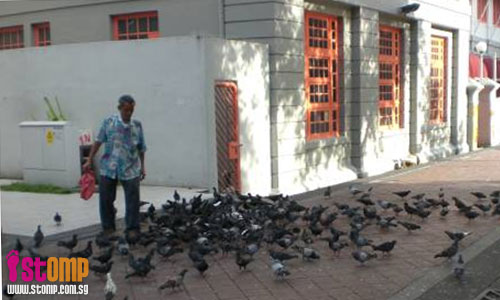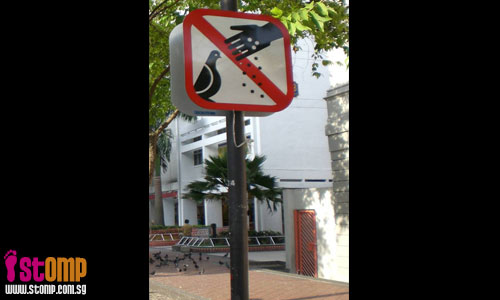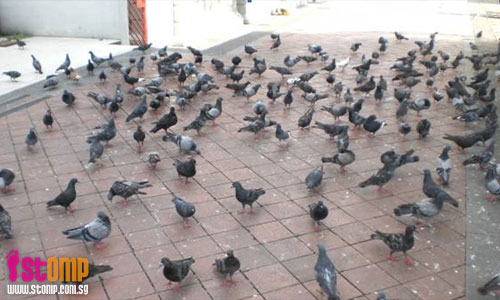
Concerned STOMPer, singelringen, saw an uncle feeding pigeons outside the Kwan Yin Temple at Bencoolen Street, and feels there should be stricter adherence to the prohibition on feeding pigeons.
Pigeons breed fast and may become a pest if people continue to ignore 'No Feeding' signs. He says:
"This uncle was seen to be feeding the pigeons despite there being several signs showing that feeding of pigeons is prohibited along Bencoolen Street outside the Kwan Yin Temple.
"When the pigeons are well fed, they tend to grow faster and produce more offspring.
"They are able to breed from the age of six months.
"One female lays two eggs at a time, and can lay up to eight times a year if well fed.
"This population explosion will eventually lead to the problems of diseases hazardous to human beings."


Related post: Neighbour always leaves food for birds! (21st January 2009)
Crazy pigeon is not afraid of people and steals food from their plates (23rd January 2009)
Bird droppings everywhere because of too many pigeons (29th January 2009)
It does seem that here in Singapore, feral pigeons (Columba livia) have few fans. Throughout human history, few other birds have been so celebrated and also so reviled.
According to the Animals and Birds Act, under the Animals and Birds, (Pigeons) Rules:
Prohibition on feeding
10. No person shall feed stray pigeons in any premises or public place.
And further down...
Offences
17. Any person who contravenes or fails to comply with rule 6 (3), 7, 8, 9, 10, 11 or 13 (1) shall be guilty of an offence and shall be liable on conviction to a fine not exceeding $500.
Pigeons are a common, nearly ubiquitous feature of many cities - Trafalgar Square in London, and Central Park in New York are just two places famous for their resident pigeon populations.
In large numbers, pigeons can create a serious pollution problems with their droppings, and also pose a health hazard. According to a paper by Haag-Wackernagel & Moch (2004),
Although feral pigeons pose sporadic health risks to humans, the risk is very low, even for humans involved in occupations that bring them into close contact with nesting sites. In sharp contrast, the immunocompromised patient may have a nearly 1000-fold greater risk of acquiring mycotic disease from feral pigeons and their excreta than does the general population.
Feeding of pigeons is such a contentious issue; it is a favourite pastime of many people, and there can be few scenes as serene as the stereotypical image of pigeons cooing away while being fed by children and old ladies. Yet feeding can contribute to an increase in the pigeon population, and any uneaten food will definitely attract pests such as cockroaches and rodents. And as I mentioned yesterday, it is likely that there are negative ecological impacts, especially on other bird species. Here, where the rock pigeon is not a native species, the impacts on native birds do not appear to have been well-studied, although I would not be surprised if there is competition for food between feral pigeons and other granivorous birds.
Here's a London-based website that discusses why people should refrain from feeding pigeons. On the flipside, here's a group that has been formed to save the iconic pigeons of Trafalgar Square.
Personally, I am ambivalent where it comes to feral pigeons. I have personally witnessed how one of the neighbourhoods I used to live in soon became quite badly polluted due to the sudden appearance of a large flock of pigeons; their droppings were everywhere, leaving unsightly stains on the ground, walls, and vehicles. The neighbourhood I currently live in has a smaller pigeon population, and although they don't bother me, I have seen rice and bread being scattered around on the ground on several occasions, and I hope that the population does not increase greatly. Similarly, there are quite a few pigeons living around my current workplace, and presently, they are not much of an issue.
Where it comes to controlling pigeon numbers, the most effective solution would be to reduce the amount of food available to them and limit potential nesting sites. Needless to say, there will always be people who flout the laws regarding feeding of birds in urban areas. The use of contraceptives and dummy eggs has also been tried out in some cities. Poisoning does not seem very effective, since it merely removes a few individuals, leaving more food available for the remaining pigeons. Besides, there is always the risk of collateral damage, when other species consume poisoned bait meant for pigeons.
One solution that cities elsewhere have explored has been to encourage various species raptors to establish themselves; urban pigeons are often the main source of food for these populations. In North American and European cities, some of the most common species include Cooper's hawk (Accipiter cooperii), northern goshawk (Accipiter gentilis), Eurasian sparrowhawk (Accipiter nisus), red-tailed hawk (Buteo jamaicensis), merlin (Falco columbianus) and peregrine falcon (Falco peregrinus).
Here in Singapore, our more common urban raptors like the white-bellied sea eagle (Haliaeetus leucogaster) and brahminy kite (Haliastur indus) are not significant predators of other birds, although we do have resident forest-dwelling species which would probably readily go for pigeon, such as the changeable hawk-eagle (Nisaetus cirrhatus) and crested goshawk (Accipiter trivirgatus). Hopefully, in the future, these birds might establish themselves in our built-up areas.
Singapore also has a few other raptor species that are winter visitors; these include the increasingly common Oriental honey buzzard (Pernis ptilorhynchus), Japanese sparrowhawk (Accipiter gularis), Chinese goshawk (Accipiter soloensis), and peregrine falcon. These birds are capable of taking pigeons, and while in Singapore, they are occasionally found close to or even within urban areas. In fact, a peregrine falcon was spotted in Sengkang in March last year. Singapore's peregrine falcons are mostly migrants from temeprate Asia, although there are resident breeding populations in nearby countries. One wonders if we might one day have our own resident urban peregrine falcons.
I suddenly find myself wondering if Hong Kong has an urban pigeon problem, given that roast pigeon is so popular over there.